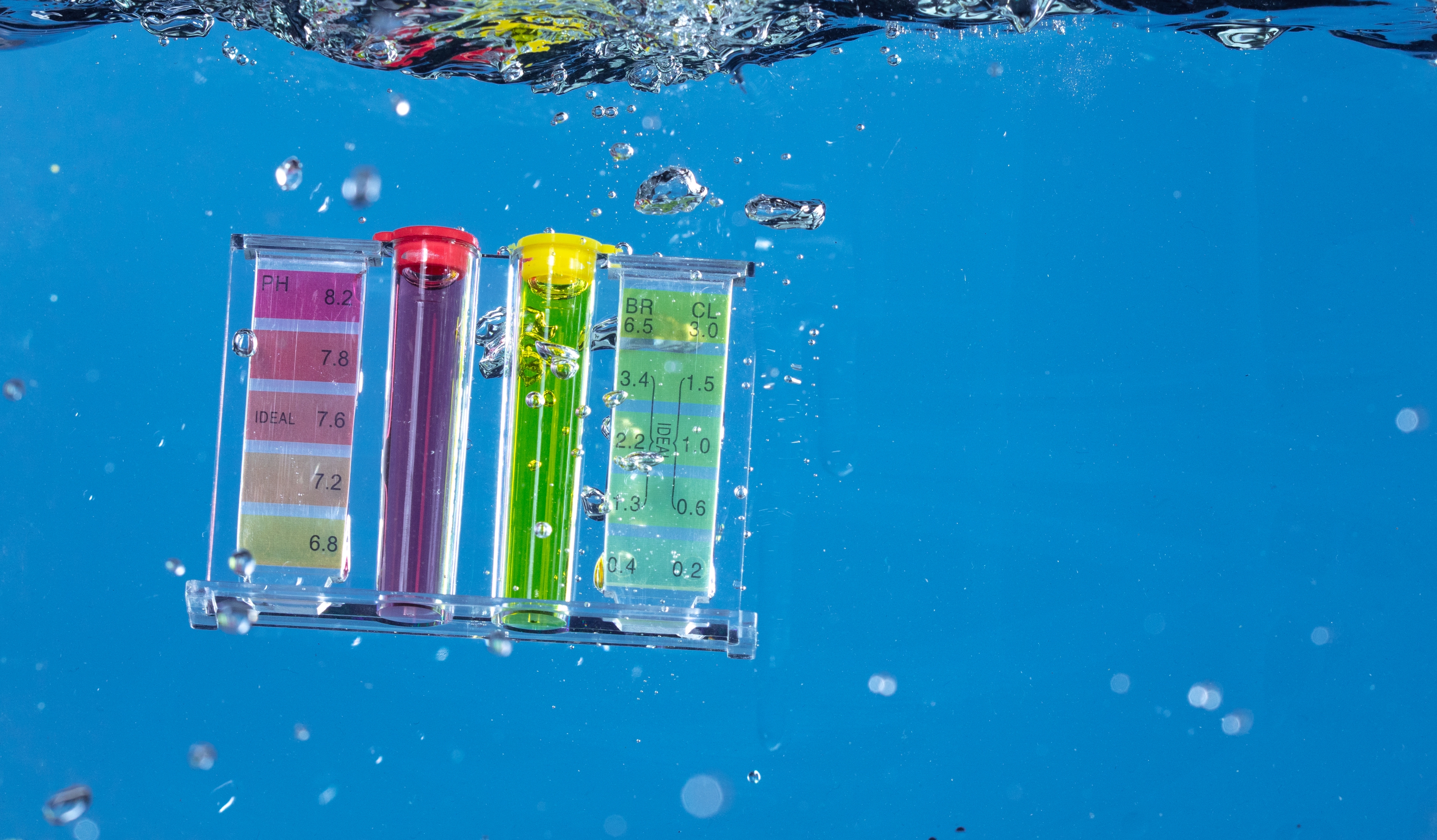How To Balance Pool Water: Step-by-Step Guide To Perfect Pool Chemistry

Chemicals are necessary for all pools, whether above ground or inground, regardless of the sanitizer used. When water is left to stagnate over long periods, it’s prone to developing bacteria, mold, and algae. You probably won’t change all of the water in your pool for many years, and while continuous filtration removes large contaminants, it won’t balance your water for you.
To balance your pool water:
- Test the Water using a test kit
- Adjust the pH to 7.2 - 7.6
- Balance the Alkalinity to 80 - 120 ppm
- Chlorinate to 1 - 3 ppm
- Check the Calcium Hardness and ensure it's between 200 - 400 ppm
- Retest after chemical adjustment
Why Balancing Pool Water Matters
Balancing pool water is crucial for the safety of both swimmers and the pool itself. Unbalanced pool water can cause skin and eye irritation, damage the pool's surface and plumbing, and reduce the effectiveness of sanitizers like chlorine, which can lead to even more dangers.
To prevent this from happening and to keep your water ready for healthy swimming, you need a mixture of pool chemicals. While each chemical serves a specific role, they often act in unison to sanitize your pool. However, simply adding chemicals at random won't clean your pool effectively and could cause more damage. Most of these chemicals must remain within a specific range to maintain their effectiveness. Having one chemical too high or too low can cause others to fall out of balance, potentially leading to contaminated water.
A balanced pool has the proper levels of pH, Total Alkalinity, Calcium Hardness, and Chlorine levels. Many of these chemical levels are measured in parts per million (ppm). Parts per million is a ratio that you'll often see in pool chemical measurements. Much like a ratio being out of a hundred, 1 ppm would equate to one pound of chemical per 1 million pounds of water (or about 120,000 gallons).
Tools and Supplies You'll Need
There are several options for testing your pool water, and the choice you make is entirely up to you.
- Liquid Test Kits - depending on which kit you get, they can be more comprehensive than test strips
- Test Strips - test strips are often quicker and easier than liquid test kits
- Digital Tests - often quicker and more comprehensive than both liquid test kits and test strips
Step 1: Test the Water
You will need to test your pool water to determine your chemical levels and the correct amounts of each chemical to add to the water, ensuring it is safe for your pool and anyone swimming in it.
How to Take a Pool Water Sample Correctly
Before taking a pool water sample, turn your pump to high and let the water circulate for at least an hour. Stagnant water samples may not be as accurate as water that has been recently circulated.
Ensure that the glass you're using is clean, and take water from as close to the center of the pool as possible. Don't take water from the surface or near any floating chemical dispensers or pool returns. Take the sample from about elbow deep.
Follow the instructions on whatever testing system you're using, whether it's a digital tester, a liquid test kit, or test strips.
Step 2: Adjust pH Levels
pH is a measurement of whether a substance, in this case, your pool water, is basic or acidic. Anything with a pH above 7 is basic, and anything with a pH below 7 is acidic. Anything and everything that enters your pool can affect the pH level of the water, so it's essential to monitor the level to ensure it remains within the optimal range.
If your pH level is too low, it can begin to corrode your pool equipment, including pumps, mechanical mechanisms, ladders, slides, and diving board bases. It can even corrode or etch the plaster in gunite pools.
If your pH is too low or too high, then it can cause eye and skin irritation in your swimmers. It strips the body of its natural oils, leaving your skin dry and itchy, and your hair brittle. Your body is naturally near the neutral point on the scale, and thus, it prefers water closer to this point. It can also damage vinyl liners by making them absorb water and create unsightly wrinkles. They will also age more rapidly, meaning you need to replace them sooner.
High pH inactivates chlorine, making it less effective. This could lead to spending more money than necessary on chlorine, while still having water that isn't clear, as many minerals come out of solution and result in murky water and mineral deposits.
What is the Ideal pH Range?
The ideal pH range is 7.2 - 7.6.
How to Raise or Lower pH
To maintain a balanced pH, adjust the water with additions of pH increasers and pH decreasers to achieve a pH level of 7.2 - 7.6. Keep both increasers and decreasers on hand to make adjustments as needed. It's also recommended to test your pH levels daily.
Step 3: Adjust Total Alkalinity
Alkalinity and pH levels are closely related. It prevents sudden pH changes by acting as a buffer, stabilizing it, and keeping it in the normal range.
Levels should be tested weekly, and alkalinity is best in the 80 - 120 ppm range.
Low alkalinity is raised by the addition of an alkalinity increaser to prevent pH drift. High levels of alkalinity are lowered by the addition of an acid (pH decreaser), allowing you to adjust the pH up or down.
Step 4: Adjust Chlorine or Sanitizer Level
A pool's sanitizer is responsible for killing bacteria in your pool water. The most common on the market is Chlorine, followed by Bromine and Biguanides. Making sure that the sanitizer in your pools remains at the proper levels prevents the growth of microscopic organisms that can in turn, lead to the outbreak of algae. Sanitizers are used up as they work, so you need to replenish them with more sanitizer on a regular basis.
Chlorine comes in many different varieties, such as slow dissolving tablets, sticks, liquid, or granular forms. Bromine is primarily available in tablet form, while biguanides are available in liquid form.
It's essential you don't mix different sanitizers (even mixing two types of chlorine), as improper mixing can lead to dangerous chemical reactions.
It's recommended that you check your sanitizer level daily and correct the levels accordingly. You should maintain a level of 1 - 3 ppm at all times.
Step 5: Check Calcium Hardness
Calcium Hardness is often referred to as how "hard" or "soft" the water is. Similar to how calcium protects the bones and teeth in your body, calcium protects the metal in your pool from scale and corrosion while also preventing water from foaming when other chemicals are added.
If these levels are too high, the water becomes saturated and will release excess particles that are then deposited on the inside of the pool. They can be attracted to lights, ladders, and small crystalline clumps, patches, or film all over the pool's surfaces. It can also mix with other contaminants.
If levels get too low, water can corrode any surfaces inside the pool that contain calcium and other minerals.
It's recommended that calcium hardness can be tested weekly, and it should be within the 175 - 400 ppm range.
Step 6: Retest and Repeat
Once you've tested and adjusted all of these chemical levels, it's essential to retest the water to ensure that any issues haven't been overcorrected.
Wait for 4 - 6 hours, or even until the next morning, so that all the chemicals can circulate and stabilize.
If the issue persists, repeat the steps above using small, measured doses. Ensure that you avoid making too many changes at once, as pool chemistry works best in small, gradual steps.
Pro Tips for Ongoing Water Balance
Keeping your pool water balanced isn't just a one-time thing; it's a routine part of pool maintenance. But you can stay ahead of problems and enjoy your crystal-clear water all season with some simple tips:
-
Test Your Water Weekly
You should test your water at least once a week, or more often if your pool is experiencing heavy use or during heat waves. You also want to check your pH levels at least once a day. Consistent testing will help ensure you can swim in it safely.
-
Balance in the Correct Order
Constantly adjust chemicals in the correct order:
Total Alkalinity → pH → Chlorine → Calcium Hardness
This not only helps to ensure the accuracy of testing and adjusting chemicals, but it also prevents chemical interference.
-
Keep a Pool Log
Keep track of your test results, chemical doses, and any issues you have in your pool. A log helps identify trends in your pool's chemistry and can save time diagnosing problems later on.
-
Watch for Weather Changes
Rain, heat, and any debris falling into your pool can all shift the chemistry of the water. After storms, or if you have an unusually high number of people in your pool, test and adjust your water more often.
-
Shock Your Pool Regularly
Shock your pool every 1 - 2 weeks to kill bacteria and oxidize contaminants, even if the water appears clean.
Check out our blog - The Beginner's Guide to Shocking Your Swimming Pool
-
Store Chemicals Properly
Keep pool chemicals sealed, dry, and out of direct sunlight. Storing your chemicals improperly can not only weaken their effectiveness but also impact their water balance.
Frequently Asked Questions
How Often Should I Test My Pool?
You should test your pool at least once a week, more often when your water is under heavy use or there's extreme weather. You should also be testing your pH daily.
What Should The pH Level of Pool Water Be?
Your pH should be between 7.2 and 7.6.
What Happens If Your Pool's pH Is Too High or Too Low?
If your pH is too low or too high, then it can cause eye and skin irritation in your swimmers. It strips the body of it's natural oils, leaving your skin dry and itchy, and your hair brittle. Your body is naturally near the neutral point on the scale, and thus it prefers water closer to this point. It can also damage vinyl liners by making them absorb water and create unsightly wrinkles. They will also age more rapidly, meaning that you need to replace them sooner.
High pH inactivates chlorine, making it less effective. This could lead to spending more money than necessary on chlorine, while still having water that isn't clear, as many minerals come out of solution and result in murky water and mineral deposits.
How Do I Lower Chlorine Levels in a Pool?
- Stop adding extra chlorine
- Leave your pool uncovered to let the UV rays help break down extra chlorine
- Dilute with fresh water
What Are The Ideal Pool Chemistry Levels?
|
Parameter
|
Ideal Range
|
Purpose
|
|
pH
|
7.2 - 7.6
|
Comfort and sanitizer efficiency
|
|
Total Alkalinity
|
80 - 120 ppm
|
pH buffer
|
|
Chlorine
|
1 - 3 ppm
|
Sanitization
|
|
Calcium Hardness
|
175 - 400 ppm
|
Protects your surfaces and equipment
|






 Pools
Pools Spas
Spas Liners
Liners Equipment
Equipment Covers
Covers Accessories
Accessories Cleaning
Cleaning  Pool Fun
Pool Fun  Clearance
Clearance
